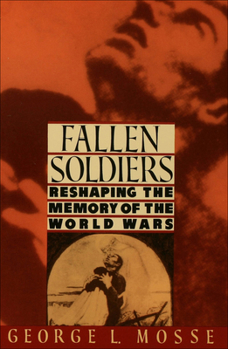Fallen Soldiers: Reshaping the Memory of the World Wars
Select Format
Select Condition 
Book Overview
At the outbreak of the First World War, an entire generation of young men charged into battle for what they believed was a glorious cause. Over the next four years, that cause claimed the lives of some 13 million soldiers--more than twice the number killed in all the major wars from 1790 to 1914. But despite this devastating toll, the memory of the war was not, predominantly, of the grim reality of its trench warfare and battlefield carnage. What...
Format:Paperback
Language:English
ISBN:0195071395
ISBN13:9780195071399
Release Date:December 1991
Publisher:Oxford University Press, USA
Length:272 Pages
Weight:0.52 lbs.
Dimensions:0.8" x 5.4" x 8.0"
Customer Reviews
1 rating
The democratization of the dead soldier
Published by Thriftbooks.com User , 14 years ago
Until late in the 19th century, the idea of burying soldiers killed in battle was a novelty, although only the tsar of Russia thought to sell the bones of his soldiers for fertilizer. But earlier, starting with the first citizen armies since the rabble of the Middle Ages, which raised up themselves to defend the French Revolution, a new attitude began to grow, inevitable with the democratization of warfare. The result, like a rocket arching up and crashing down far off, is examined in George Mosse's "Fallen Soldiers." To an American, used to veterans' cemeteries and memorials to war dead in every town, the fact that these didn't exist 200 years ago comes as a surprise. Before that time there were battle monuments to defunct kings and generals, but the body of the common soldier, even as late as the Battle of Waterloo in western Europe and much later farther east, was left to dogs and crows to dispose of. Slowly, a new sensibility grew up, spurred on by the existence of something new, the volunteer. The age of mass slaughter also introduced the concept of fighting for a belief. Such men, some of them articulate representatives of the middle class, could not be left for crows. Thus was created a Myth of the War Experience, compounded of feelings of camaraderie, nationalism, sometimes religion and masculinity. Mosse does not mention also sentimentality, but that too had its impact. (In this respect, the novelist Norah Lofts, in her biography of Emma Hamilton, has the arresting picture of Nelson's captains weeping as they carried her body to the grave. There never were tougher men, but they were romantics, too. It is impossible to imagine such an event at any earlier time.) Along the way, Mosse, who held professorships in Madison and Jerusalem, retrieves the fascinating history of the invention of the modern cemetery (in America), tin soldiers and postcards. All were brought into the service of the Myth of War Experience, which separated the fighting soldier from the rest of his country. The peak of the sentiment came in World War I and after, as Europe had to learn how to deal with battle deaths in unprecedented numbers. However, Mosse is not merely interested in relating a new way of treating the dead -- though he does not make the point, during the same 19th century the chances of a poor civilian's ending up in an anonymous grave decreased also. He is more interested in the Myth of War Experience as it related to nationalism and the brutalization of postwar politics, especially in Germany. The Myth had a lot to do with the willingness of Europeans to refight the Great War, but the outcome of that event killed off the Myth. Mosse is not persuaded that it could never be revived, but at least when "Fallen Soldiers" was published in 1990, it seemed dead everywhere except in Russia. Since then, we have perhaps seen a small-scale recrudescence of it in the Balkans.




